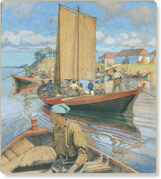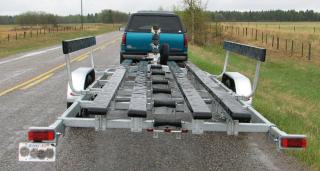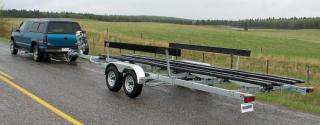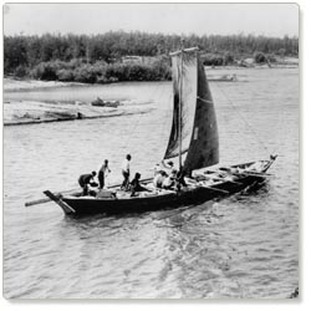What is a York boat?
From Wikipedia, the free encyclopedia
The York boat was an inland boat used by the Hudson's Bay Company to carry furs and trade goods along inland waterways in Rupert's Land. and the Columbia District. It was named after York Factory, the headquarters of the HBC, and modeled after Orkney Islands fishing boats (themselves a descendant of the Viking long boat). York Boats were preferable to the canoes, used by Nor'west Company Voyageurs as a cargo carriers, because of its larger size, greater capacity, and improved stability in rough water. The boat's heavy wood construction also gave it an advantage in travelling through rocks or ice; it was much more immune to tears and punctures. That advantage became a disadvantage, though, when portaging was necessary. The boat was far too heavy to carry, and it was necessary instead to cut a path through the brush, lay poplar rollers, and laboriously drag the boat overland. Regardless of the circumstances, crewing a York boat was an arduous task, and those who chose this life faced "unending toil broken only by the terror of storms," according to explorer Sir John Franklin. The York boat had a length of about 14 metres (46 ft) and the largest could carry over six tonnes (13,000 lb) of cargo. It had a pointed bow, a flat bottom, and a stern angled upward at 45 degrees, making beaching and launching easier. The boat was propelled both by oars and by a canvas sail, and steered with the use of a long steering pole., or a rudder when under sail. It had a crew of between six and eight men. The first boat was built in 1749 and by the late 18th century, boat building stations existed from James Bay to Fort Chipewyan. The advent of the steamboat at the beginning of the 19th century signaled the end for the York boat.. A style of boat slightly different from the York boat was made specifically for use in the Columbia District and constructed on the Columbia River. In 1811 the American Pacific Fur Company introduced the use of bateaux on the Columbia River, heavy boats made of split or sawn cedar. After the NWC took over the PFC the practice of using bateaux was quickly adopted, birch bark canoes having proved too dangerous on the rivers of the Pacific Northwest. In the 1820 Joe McKay of the HBC described the Columbia District bateaux as "made from quarter-inch pine board, and are thirty-two feet long, and six and a half feet wide in midships, with both ends sharp, and without a keel—worked, according to the circumstances of the navigation, with paddles, or with oars."[1] Travelling from Lake Winnipeg to Hudson Bay by York boat was the subject of the Canadian TV documentary Quest for the Bay in 2002. York boat races can still be seen in Norway House, Manitoba. Racers compete for a $25,000 top prize in a celebration called Treaty & York Boat Days. Our york Boat Project:In 2011, North Woods Canoe Company, completed the construction of a ¾ scale replica York Boat from the Fur Trade era.
An important part of this project is the ability to transport the completed York Boat to different launch sites. As well the York Boat is being utilized in displays at numerous tourism events, parades, trade fairs, and exhibits throughout the country. North Woods Canoe has designed a specialty trailer to transport the York Boat.. The design criteria for the trailer: ♦ Keep the overall width under 102" wide so the unit can be easily pulled with a pickup truck on highways and rural roads. ♦ Load and unload in varied water conditions such as rivers and flatwater. ♦ Have a low profile to provide viewing of the York Boat on the trailer at static venues. ♦ Fully support the keel on a roller system to ease in loading. ♦ Provide rollers for initial alignment of York Boat to the trailer. ♦ Provide side bunks to align and guide the York Boat when loading and unloading. ♦ Bunk area under hull to be double each side to provide hull support and to be covered with "slick bunks" to aid in loading and unloading. ♦ Utilize tandem axles, with brakes and break away safety kit to carry the load, with stabiltiy. ♦ Provide "EZ Lube spindles on axles" for wheel bearing maintenance. ♦ Incorporate an electric winch and bow support to aid in loading and securing the load. ♦ Provide tie down points and ratchet straps to secure the load. ♦ Fully galvanize the unit to keep maintenance "low to no" 14lm2-18
|
INTERESTING Info:For over a century the York boat was the main mode of transportation between the inland trading posts and York Factory, the major transshipment point at the mouth of the Hayes River on Hudson Bay. Named after its ultimate destination early versions of the vessel were operating in 1746 at Fort Albany. In the years following 1821 the York boat grew to replace the canoe for freight. The reason for its introduction was its superior payload: the boats could carry more than 3 tons of goods, about three times the capacity payload of the largest canot du nord. Based on an old Orkney design that in turn derived from the Viking longship, the boats were built by Orkneymen recruited by the Company specifically for their boat building skills. Many different posts had men assigned to the task of boat building. They used local wood and imported iron forged by the post's blacksmith as materials. Long and flat-bottomed, the York boat's pointed bow and stern angled upwards at forty-five degrees, which made it easy to beach or backwater off a sandbar Hudson's Bay Company York Boats at Norway House by Walter J. Phillips, 1928

Each boat was propelled by six or eight oarsmen working oars over 6 metres in length. The oars alone weighed just over 11 kilograms. To balance them the oarsman was seated on the opposite side of the boat from the oar lock. He stood up to push the oar forward and sat down as he pulled his stroke. Pure brute strength pulled the men from one post to the next, and they often rowed for up to sixteen hours a day. When the rivers were shallow the boats were poled, when very swift they were "tracked", pulled with two ropes by the crew along the bank. When the wind was from behind, a square sail was used, to the relief of the oarsmen. For open water, the York boat was equipped with a mast, which could be dismantled, about 2.7 metres long and large square sail. The sail not only enabled it to sail on large rivers or lakes but also served as atent at night. A typical boat would measure 12.6 metres in total length, reach 9.1 metres to the keel and have an inside depth of 0.9 metres. Boats typically lasted about three years before having to be replaced. Clinker-built of heavy timber, with each plank overlapping the next, the boats were strong. While they could survive the battering of fast-flowing northern rivers, portaging them was difficult, but not impossible. Boats had to be dragged via ropes and rollers along pre-cleared trails. Since the boats usually travelled in brigades, there was always sufficient manpower available to accomplish this. Also, there were established tramways along the route that could be used to move the boat. Remains of these trails are still visible today. Robinson Portage on the Hayes River in particular has some well preserved remnants of the old tramway which was used to transport the York boats around the rapids York boat, Split Lake, Northern Manitoba, 1928.
|






